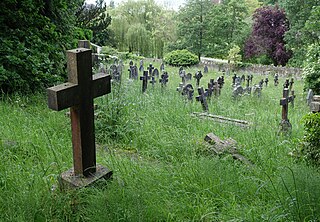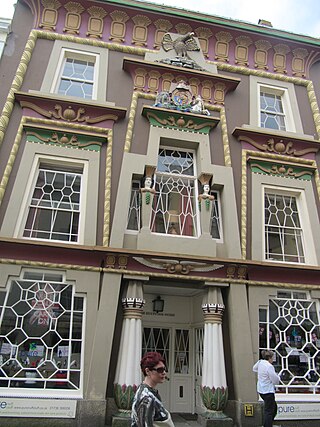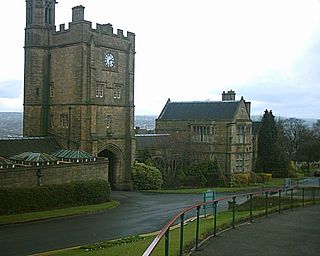
Kensal Green Cemetery is a cemetery in the Kensal Green area of Queens Park in the Royal Borough of Kensington and Chelsea in London, England. Inspired by Père Lachaise Cemetery in Paris, it was founded by the barrister George Frederick Carden. The cemetery opened in 1833 and comprises 72 acres (29 ha) of grounds, including two conservation areas, adjoining a canal. The cemetery is home to at least 33 species of bird and other wildlife. This distinctive cemetery has memorials ranging from large mausoleums housing the rich and famous to many distinctive smaller graves and includes special areas dedicated to the very young. It has three chapels and serves all faiths. It is one of the Magnificent Seven cemeteries in London.

West Norwood Cemetery is a 40-acre (16 ha) rural cemetery in West Norwood in London, England. It was also known as the South Metropolitan Cemetery. One of the first private landscaped cemeteries in London, it is one of the "Magnificent Seven" cemeteries of London, and is a site of major historical, architectural and ecological interest.

Key Hill Cemetery,, originally called Birmingham General Cemetery, is a cemetery in Hockley, Birmingham, England. It opened in 1836 as a nondenominational cemetery, and is the oldest cemetery, not being in a churchyard, in Birmingham. The principal entrance is on Icknield Street to the west, with a secondary entrance on Key Hill to the north. The cemetery contains the graves of many prominent members of Birmingham society in the late 19th century, to the extent that in 1915 E. H. Manning felt able to dub it "the Westminster Abbey of the Midlands".

Anfield Cemetery, or the City of Liverpool Cemetery, is located in Anfield, a district of Liverpool, Merseyside, England. It lies to the northeast of Stanley Park, and is bounded by Walton Lane to the west, Priory Road to the south, a railway line to the north, and the gardens of houses on Ince Avenue to the east. The cemetery grounds are included in the National Register of Historic Parks and Gardens at Grade II*.

Ranmoor is a suburb of the City of Sheffield, England. It is an affluent suburb in the Fulwood ward of the city. It mostly developed in the late 19th and early 20th centuries, and it features a number of large houses that were built for the city's steel magnates, as well as, most notably, a large church, St John's. This church was opened 24 April 1879 but was almost entirely destroyed by fire on 2 January 1887. All that survived from the original church was the tower and spire, which still stands today. A new building was built and the church reopened on 9 September 1888; it is now a Grade II* listed building. A row of early 19th century buildings near the church includes the Bull's Head and Ranmoor Inn public houses.


York Cemetery is a cemetery located in the city of York, England. Founded in 1837, it now encompasses 24 acres and is owned and administered by The York Cemetery Trust with support of the Friends of York Cemetery. It is situated on Cemetery Road in the Fishergate area of York. It has approximately 28,000 graves and over 17,000 monuments, six of which are Grade II-listed. The chapel is a Grade II* listed building, while the gatehouse, gate and railings are Grade II. The architect of these buildings and the grounds was James Pigott Pritchett.

Warstone Lane Cemetery,, also called Brookfields Cemetery, Church of England Cemetery, or Mint Cemetery, is a cemetery dating from 1847 in Birmingham, England. It is one of two cemeteries in the city's Jewellery Quarter, in Hockley. It is no longer open to new burials.

The cemetery has had various titles including The Cemetery by the Common, Hill Lane Cemetery and is currently known as Southampton Old Cemetery. An Act of Parliament was required in 1843 to acquire the land from Southampton Common. It covers an area of 27 acres (11 ha) and the total number of burials is estimated at 116,800. Currently there are 6 to 8 burials a year to existing family plots.

The City of London Cemetery and Crematorium is a cemetery and crematorium in the east of London. It is owned and operated by the City of London Corporation. It is designated Grade I on the Historic England National Register of Historic Parks and Gardens.

Dissenters' Chapel, Kensal Green, is a working chapel with gallery attached in Kensal Green Cemetery, North Kensington, London. It is recorded in the National Heritage List for England as a designated Grade II* listed building, and is under the care of the Historic Chapels Trust.

Todmorden Unitarian Church is a Unitarian church located in Honey Hole Road, Todmorden, West Yorkshire, England. Built in honour of John Fielden, a local mill owner and a social reformer, the church was completed in 1869. It was declared redundant in 1987 and came under the care of the Historic Chapels Trust. Since 2008, regular services have been held in the building, but it remains in the care of the Trust. The church is recorded in the National Heritage List for England as a designated Grade I listed building,

Smallcombe Cemetery is on the edge of Bath, Somerset, England, in a valley between Widcombe Hill and Bathwick Hill. It has two distinct parts, the Anglican section known as St Mary's Churchyard and the nonconformist section known as Smallcombe Vale cemetery; they are sometimes known together as Smallcombe Garden cemetery. The two cemeteries have been closed to new burials since 1988 and are maintained by Bath and North East Somerset Council. The Bath Corporation had assumed responsibility for both cemeteries in 1947.

St Thomas is a former Anglican church in the Brightside area of Sheffield in England which now serves as a circus training school.

Meadrow Unitarian Chapel is a Unitarian chapel in the Farncombe area of Godalming, Surrey, England. It is part of the London District and South Eastern Provincial Assembly of Unitarian and Free Christian Churches, one of 16 districts within the General Assembly of Unitarian and Free Christian Churches, the umbrella organisation for British Unitarians.

Egyptian Revival architecture in the British Isles is a survey of motifs derived from Ancient Egyptian sources occurring as an architectural style. Egyptian Revival architecture is comparatively rare in the British Isles. Obelisks start appearing in the 17th century, mainly as decorative features on buildings and by the 18th century they started to be used in some numbers as funerary or commemorative monuments. In the later 18th century, mausoleums started to be built based on pyramids, and sphinxes were used as decorative features associated with monuments or mounted on gate piers. The pylon, a doorway feature with spreading jambs which support a lintel, also started to be used and became popular with architects.

Tiverton Cemetery is the burial ground for the town of Tiverton in Devon. The cemetery covers eight acres and is owned and maintained by Mid Devon Council.
Manchester is a city in Northwest England. The M21 postcode area of the city includes the suburb of Chorlton-cum-Hardy. This postcode area contains 19 listed buildings that are recorded in the National Heritage List for England. Of these, one is listed at Grade II*, the middle of the three grades, and the others are at Grade II, the lowest grade. The area is mainly residential. It also contains Southern Cemetery, and a number of buildings associated with this are listed, including structures at the entrance, the chapels, a memorial, and the crematorium. Most of the other listed buildings are houses, and also included are a church, a public house and hotel, the gateway to a former church, a library, and a war memorial.

West Street Cemetery on West Street in Farnham in Surrey is one of four cemeteries in the Farnham area owned and maintained by Farnham Town Council. The two Cemetery chapels have been Grade II listed buildings on the Historic England Register since 1990.

























